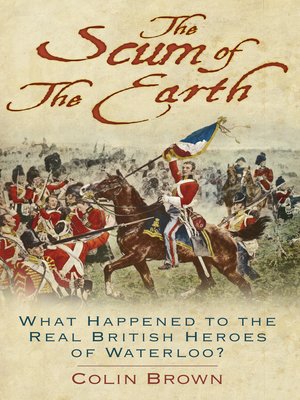
Sign up to save your library
With an OverDrive account, you can save your favorite libraries for at-a-glance information about availability. Find out more about OverDrive accounts.
Find this title in Libby, the library reading app by OverDrive.



Search for a digital library with this title
Title found at these libraries:
| Loading... |
The Scum of the Earth follows the men Wellington called just that from victory at Waterloo to a Regency Britain at war with itself, and explodes some of the myths on the way; such as that the defeat of Napoleon ended the threat of revolution spreading from France. Did the victorious soldiers return to a land fit for heroes? They did not. There was the first of the Corn Laws in the same year as the battle, there was famine and chronic unemployment. In 1819, the Peterloo massacre saw 15 killed and at least 500 injured when cavalry sabred a crowd demanding parliamentary reform. Peace in Europe perhaps for 50 years – but at home, repression and revolution in the air. And at the same time, the sheer exuberance of the Regency period, with new buildings, new art, even 17 new colonies more or less accidentally acquired. By 1848 the whole of Europe was once more set for complete upheaval. There is no one better to take a cold, hard look at the battle itself and its aftermath, in order to save us from an anniversary of misty-eyed backslapping, than political editor Colin Brown.|The Scum of the Earth explores the common soldiers the Duke of Wellington angrily condemned as 'scum' for their looting at Vitoria, from their great victory over Napoleon at the Battle of Waterloo in 1815 to their return home to a Regency Britain at war with itself. It follows men like James Graham, the Irishman hailed as the bravest man in the British Army for his heroic action in closing the north gate at Hougoumont, and fresh documentary evidence that he was forced to plead for charity because he was so poor; Francis Styles, who went to his grave claiming that he had captured the eagle that was credited to his superior officer; and John Lees, a spinner from Oldham who joined up at 15, braved shell and shot to deliver ammunition to the guns at Waterloo and was cut down four years later at the Peterloo Massacre by some of the cavalry with whom he served. All this is set against a backdrop of civil unrest on a scale unprecedented in British history. The Regency age is famous for its elegance, its exuberance, the industrial revolution that made Britain the powerhouse of Europe and the naval might that made it a global superpower. But it was also an age of riots and the fear that the mob would win control just as it had done in Paris. Britain came closer to bloody revolution than ever before or since, as ordinary men – including some of the men whom Wellington called the scum of the earth – took to the streets to fight for their voices to be heard in Parliament. The riots were put down by a series of repressive measures while Wellington stood like a bastion against the tide of history. He was defeated with the passage of the Great Reform Act in 1832. There is no one better placed to take a cold, hard look at the battle and its aftermath in order to save us from a bicentenary of misty-eyed backslapping than a former political editor with a reputation for myth busting. Colin Brown provides original research into the heroes of Waterloo and the myths that have clouded the real story.






